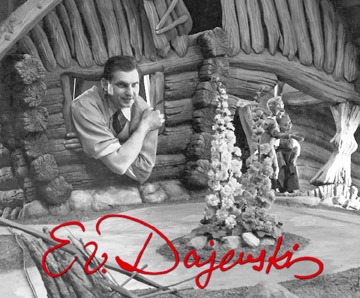Evalds Dajevskis (1914-1990) lived between two watershed events of the 20th century: the beginning of World War I in August 1914 and the collapse of the Soviet Union, when Latvia regained its independence. Dajevskis’ artistic expression represents different milestones over his lifetime. It also interprets moments from 20th century history that reshaped his life and molded his identity, as he worked as a scenographer and easel painter in Latvia, postwar Germany and the United States.
Dajevskis was born on May 28, 1914 in Volosovo, Russia, about 50 miles from the city of St. Petersburg. At age 4, Evalds Dajevskis had to flee westward, as the Winter Palace was stormed by a detachment of Red Army soldiers in 1917 marking the birth of the Soviet state. Riding on his father’ shoulders through forests and marshlands, the family made its way to safety at Dajevskis’ grandfather’s farm in Latvia.

His first studies in art began at the School of Decorative Arts in the city of Liepaja, Latvia, located on the eastern shores of the Baltic Sea. By 1936 he received a position with the “Riga Little Theater” as a stage designer. During this time period, he continued his art studies under Ansis Cirulis, one of the outstanding Latvian masters of design. Evalds Dajevskis worked professionally as a scenographer for the Liepaja Opera, Drama and Ballet Theater from 1941 to 1944, before the events of World War II resulted in his displacement from Latvia to life in post-war Germany’s refugee camps.
Living in the British zone of occupation in Germany from 1945 to 1951, Dajevskis helped create a traveling theater that performed throughout western Germany’s displaced persons camps. He created sets for the theater company and painted the camps and the war-torn cities of post-war Germany.
In 1951, Evalds Dajevskis immigrated to the United States and took up residence in New York City. In the following year, he began designing sets for the Michael Myerberg film production of Humperdinck’ opera Hansel and Gretel. By 1956 Dajevskis was admitted as a member to the United Scenic Artists union and became active in scenic painting for Broadway plays, ballet and opera at Lincoln Center.
Some of the places that Evalds Dajevskis painted in New York portrayed the waterfront along the East River. He particularly loved the old dock buildings that were abandoned along the river, the tugboats and barges out on the river along with the eroding harbor infrastructure. The striking visual form of lower Manhattan’s skyline and the elevated subway structures became favorite themes for his outdoor studies. During this time period, Evalds Dajevskis also designed stage sets for the American Latvian Theater which traveled to émigré audience along the east coast and throughout the Midwest.
In 1988, Evalds Dajevskis was invited to Riga to attend an exhibition of his set designs for theater in Germany and the United States. The trip marked his first return to Latvia after living 54 years abroad. Upon his return to New York, he painted The Old Gates / Occupied Riga, in which he responded to what he saw of the physical deterioration of Riga. The painting depicts sabers and blades tearing apart Riga's coat of arms, a symbol of the city. The coat of arms under siege became a literal metaphor for him. Its symbols are subject to the same dilapidation as the city: its towers are decayed, its gate mangled. Completed in 1989, the painting was probably Evalds Dajevskis most political work, as it addressed the era of Soviet occupation that directly changed his life and that of his countrymen forever. He died in 1990 and unfortunately would never witness the remarkable reconstruction of Riga after Latvia regained its independence in 1991.
PAINTING ORGANIZATION
The Evalds Dajevskis painting reproductions available from the RequestAPrint site are grouped into several thematic categories of paintings and design work. They were created over the course of the artist’s lifetime. Paintings in this site are preceded with a code reflecting a range of themes that Dajevskis explored in his work. They include:
Ancient Places (AP)
American Stories (AS)
City of Riga (CR)
Places of Fantasy (PF)
War and Displacement (WD)
Theater and Film (TF)
| Exhibition of Works: Oct. 4, 2012 - Nov. 17, 2012 |
Embassy of Latvia |
http://latviansonline.com/commentary/article/8349/ http://www.examiner.com/article/joyful-exhibition-of-dajevskis-artwork-on-display-at-latvian-embassy |
| Exhibition of Works: January 26, 2012 - February 3, 2012 |
The Latvian Society 531 North 7th Street Philadelphia, PA 19123 |
| The Washington Diplomat - Read The Review |